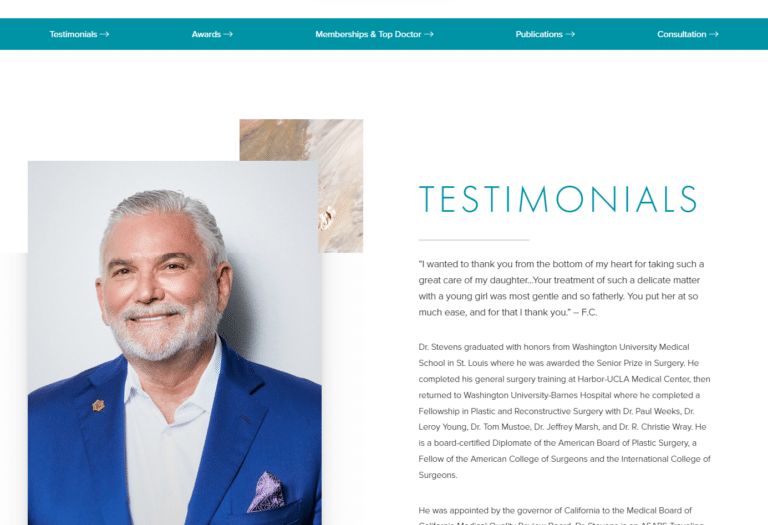The management of a physician’s online reputation is an often overlooked but absolutely critical aspect of healthcare marketing. Today, more than ever, physicians and other healthcare practitioners must build and maintain an online reputation that resonates with trust, expertise, and unmatched patient care in order to be successful.
At Thunderhead Marketing, we specialize in the niche of healthcare marketing with a laser focus on physicians. Through this comprehensive guide, we delve into the art and science of physician reputation management to equip physicians and other healthcare providers with actionable strategies to bridge the gap between traditional healthcare delivery and its digital perception.
From understanding the shifting dynamics of patient expectations to mastering the digital tools at your disposal, this ultimate checklist for physician reputation management will serve as your compass in the quest to enhance your professional standing in a world where the line between online and offline reputation blurs more each day.
The Impact of Online Reviews
The internet serves as the first port of call for most people seeking healthcare information, and online reviews have become the linchpin in shaping a physician’s reputation on the web. Platforms such as Google, Healthgrades, and RateMDs have emerged as the new town squares, where patient testimonials can make or break the public perception of a medical professional’s practice. The weight of these digital endorsements is monumental, often serving as the deciding factor for potential patients as they navigate their healthcare choices.

The Digital Word-of-Mouth
Online reviews are the digital equivalent of word-of-mouth recommendations, carrying a profound impact on patient decision-making. A glowing review can bolster a physician’s credibility, portraying them as trustworthy and skilled, thereby attracting more patients. Conversely, negative feedback can deter potential patients, no matter what the physician’s actual level of competence is and the quality of care provided. This digital word-of-mouth extends far beyond personal acquaintance, reaching a vast audience of potential patients.
The Psychology Behind Reviews
The influence of online reviews on patient decision-making can be attributed to social proof, a psychological phenomenon where people assume the actions of others in an attempt to reflect correct behavior for a given situation. When patients share their positive experiences, it not only enhances the physician’s reputation but also instills confidence in prospective patients. This trust is pivotal in a field as intimate and crucial as healthcare, where the choice of a healthcare provider can have significant implications for one’s well-being.
Turning a Negative Review into a Positive
While positive reviews can amplify a physician’s standing, negative reviews offer an opportunity for reflection and growth. They provide insight into areas that may require improvement, whether it be bedside manner, office wait times, or communication practices. Furthermore, the manner in which a physician or their practice responds to negative feedback can itself be a testament to their professionalism and commitment to patient satisfaction. A thoughtful, empathetic response to criticism can mitigate the impact of a negative review and even turn it into a positive showcase of the physician’s dedication to patient care.
The Checklist for Managing Physician Reputation
Online physician reputation management is an ongoing process that requires attention, strategy, and a proactive approach. To navigate this complex landscape successfully, we’ve compiled an essential checklist designed to help physicians enhance their online presence and strengthen their relationships with patients. Implementing these steps can lead to a robust reputation that attracts new patients while retaining the trust of current ones.
1. Audit Existing Online Presence
- Search Your Name: Begin by conducting searches for your name and your practice on major search engines and healthcare review sites. This will help you understand what patients see and say about you.
- Evaluate Profiles and Reviews: Look at your profiles on review sites, social media, and professional directories. Assess the feedback and overall sentiment.
- Identify Areas for Improvement: Note any recurring themes in feedback, both positive and negative. These can guide your reputation management efforts.
2. Claim and Optimize Online Profiles
- Claim Profiles: Ensure you have claimed your profiles on all relevant review sites, such as Healthgrades, RateMDs, and Google My Business.
- Update Information: Keep your contact information, office hours, and services offered up-to-date. Accurate information is crucial for patient trust and SEO.
- Showcase Your Expertise: Use these profiles to highlight your specialties, certifications, and any awards or recognitions you’ve received. Your website bio page is a great place to pull information from.
3. Generate Positive Reviews
- Encourage Feedback: After a visit, encourage satisfied patients to share their experiences online. Make the process easy by providing links to your profiles.
- Incentivize the Practice: While you should never buy reviews, consider creating a culture that values feedback, such as recognizing staff members who get mentioned in positive reviews.
4. Respond to Reviews
- Acknowledge Feedback: Respond to both positive and negative reviews professionally and promptly. Thank patients for positive feedback.
- Address Concerns: For negative reviews, apologize where appropriate and offer to discuss the matter offline to find a resolution. This shows commitment to patient satisfaction.
5. Monitor Online Mentions
- Use Alerts: Set up Google Alerts for your name and your practice to monitor new mentions online.
- Regular Check-ins: Make a habit of periodically checking your online presence to stay aware of what’s being said about you.
6. Engage with the Community
- Participate in Forums: Join health-related discussions online to showcase your expertise and care for community well-being.
- Local Involvement: Engage in local community events or health fairs to build a positive public image and connect with potential patients.
7. Content Creation
- Start a Blog: Share your knowledge and expertise through a blog on your website. Discuss common health concerns, latest trends in healthcare, and wellness tips.
- Utilize Social Media: Post helpful health tips, office updates, and community involvement on platforms like Instagram, Facebook, and LinkedIn to maintain a positive, active online presence.
8. Professional Networking
- Connect with Peers: Network with other healthcare professionals online and offline. This can lead to referrals and positive endorsements.
- Join Professional Associations: Being active in professional associations can boost your credibility and online visibility.
By systematically addressing each item on this checklist, physicians and healthcare practitioners can significantly improve their online reputation. Remember, reputation management is a marathon, not a sprint. Consistency, authenticity, and engagement are key to building and maintaining a reputation that reflects the high quality of care you provide.
Implementing the Reputation Checklist
Taking the leap from understanding the importance of physician reputation management to actively implementing the strategies outlined in our checklist can seem daunting. However, breaking down the process into manageable steps and integrating these activities into your daily or weekly routine can make the task both achievable and less overwhelming.
Here’s how to practically apply the checklist, ensuring a comprehensive approach to enhancing your online presence and patient relations:
Start with a Plan
- Prioritize Actions: Based on your initial audit, prioritize the areas that need immediate attention. This could mean updating your profiles, responding to recent reviews, or generating new content.
- Set Realistic Goals: Define clear, achievable goals for your reputation management efforts, such as improving your average rating on review sites or increasing patient engagement on social media.
Incorporate into Daily Routine
- Dedicate Time: Allocate specific times in your week for reputation management tasks. Even 30 minutes can make a significant difference over time.
- Involve Your Team: Make reputation management a team effort. Assign roles and responsibilities to staff members, such as monitoring reviews or updating social media profiles.
Leverage Technology
- Use Tools and Software: Consider using reputation management software that can help monitor reviews, track online mentions, and even automate responses to certain types of feedback.
- Automate Where Possible: Use scheduling tools for social media posts and blog articles to maintain a consistent online presence without having to manually update each platform every day.
Engage with Your Audience
- Personal Touch: Personalize your responses to reviews and online interactions. This shows that you value patient feedback and are committed to improving their experience.
- Stay Active: Regularly post fresh content, participate in discussions, and update your profiles to keep your online presence vibrant and engaging.
Making It a Part of Your Practice’s Culture
Embedding reputation management into the fabric of your practice’s culture is crucial for long-term success. Encourage an environment where every team member understands the value of a positive online presence and is motivated to contribute positively to the practice’s reputation. Celebrate successes, learn from feedback, and continuously strive for excellence in both patient care and online engagement.
By thoughtfully implementing the checklist into your practice’s operations and culture, you’re not just managing your reputation; you’re actively shaping the narrative of your professional legacy. This proactive approach to physician reputation management not only enhances your online presence but also strengthens the trust and loyalty of your patients, paving the way for a thriving practice rooted in excellence and integrity.
Don’t Have Time for Reputation Management? Our Experts Can Help
Managing your online reputation effectively is crucial but can be time-consuming and complex. You entered healthcare to make a difference in patients’ lives, not to spend your days navigating the intricacies of digital marketing. If dedicating time to reputation management feels overwhelming or detracts from your primary mission of providing care, Thunderhead Marketing is here to shoulder the burden.
With our reputation management services, you get:
- Tailored Support for Busy Physicians: Understandably, your focus is on your patients. Let us take care of your digital presence, so you can concentrate on what matters most — providing exceptional care.
- Expert Strategies, Minimized Effort: With our expertise in healthcare marketing and reputation management, we implement sophisticated strategies that require minimal effort on your part but deliver maximum impact.
- Achieve More, Stress Less: Enhancing your online reputation shouldn’t add to your workload. Our services are designed to streamline this process, offering peace of mind and freeing up your time for the work you love.
With our support, you can enhance your online presence, attract more patients, and build a stronger, more trusted practice — all without diverting focus from your essential work.
Measuring Success Is Key

Gauging the impact of your efforts is crucial for understanding what strategies are working and where adjustments need to be made. Success in managing your online reputation can be measured through a variety of metrics that reflect both your digital presence and its influence on patient acquisition and retention. Here are key indicators to track and assess the effectiveness of your reputation management strategies.
Online Rating Improvements
- Average Star Ratings: Monitor the average star ratings on key review platforms over time. An upward trend is a strong indicator of success in managing your online reputation.
- Number of Positive Reviews: Keep track of the number of positive reviews you receive across platforms. An increase in positive feedback reflects a growing satisfaction among your patients.
Search Engine Rankings
- Visibility in Search Results: Observe your practice’s position in search engine results for relevant keywords. Higher rankings can indicate effective SEO strategies and a positive online reputation.
- Local Listings Performance: For practices with a local patient base, success in local search listings (like Google My Business) is essential. High visibility in local searches often correlates with improved reputation and patient trust.
Patient Feedback and Engagement
- Patient Surveys: Conduct periodic surveys to gather direct feedback from your patients regarding their experiences and satisfaction. Look for trends in responses over time to evaluate the impact of any changes you’ve implemented.
- Engagement on Social Media: Assess the level of interaction with your posts, including likes, shares, and comments. Increased engagement can indicate that your content resonates with your audience, contributing positively to your reputation.
Website Traffic and Conversion Rates
- Website Analytics: Monitor the traffic to your practice’s website, noting any increases in visits, particularly from organic search. More traffic can signal greater visibility and interest.
- Appointment Bookings: Track the number of new patient appointments or inquiries through your website or via phone. An increase in bookings is a direct outcome of a successful reputation management strategy.
Referrals and Patient Retention
- Referral Rates: Measure the number of new patients referred to your practice by existing patients. A healthy referral rate often reflects a strong reputation and high patient satisfaction.
- Patient Retention Rates: High retention rates indicate that your existing patients continue to trust and value your care, an indirect measure of your reputation’s strength.
Benchmarking Against Goals
Set specific, measurable goals at the outset of your reputation management efforts and regularly benchmark your performance against these objectives. Whether it’s improving your average rating by half a star, increasing your positive reviews by 20%, or enhancing your search engine rankings, having clear targets will help you focus your efforts and measure success more effectively.
Continuous Improvement
Measuring success in reputation management is not a one-time task but an ongoing process. The online world and patient expectations are continually evolving, requiring you to adapt and refine your strategies. Regularly review your metrics, celebrate your successes, and identify areas for improvement. This cycle of evaluation and adjustment will not only help you maintain a positive reputation but also foster a practice that consistently meets and exceeds patient expectations, thereby ensuring long-term success in an increasingly competitive healthcare environment.
Your Reputation Deserves Expert Care
If the thought of managing your online reputation feels daunting, or if you simply prefer to invest your energy directly into patient care, Thunderhead Marketing is your ideal partner. We specialize in turning the complexities of digital reputation management into straightforward success stories for physicians like you. Don’t let the digital world distract you from your passion! Let Thunderhead Marketing amplify your voice online, while you continue to make a difference in the real world. Contact us today to learn more about our online reputation management services for doctors.
Want to know how your online reputation compares to your competitors? Get your free reputation scorecard here.






![How Doctors Can Respond to Online Reviews Without Violating HIPAA [FREE TEMPLATE]](https://thunderheadmarketing.com/wp-content/uploads/2024/06/Respond-to-Online-Reviews-Without-Violating-HIPAA-768x671.jpg)